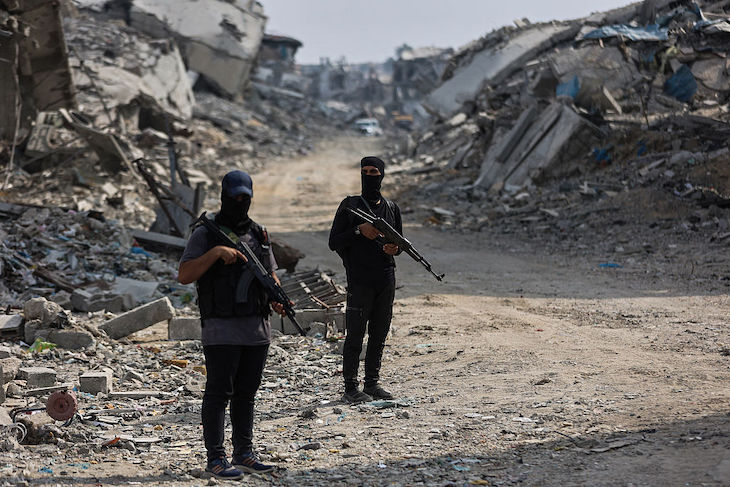
A good place to catch the highbrow sports journalist in action is the ‘Pseuds Corner’ column of PrivateEye, where he (and it’s always a ‘he’) regularly appears. Here you will discover that to contemplate Manchester City’s mid-season loss of form is ‘like sitting in Rome in 410 and watching the Visigoths pour over the horizon’, warm to the spectacle of Liverpool’s Virgil van Dijk ‘striding about the place like the 17th Earl of Egham with a quiver of pheasants over one shoulder’, or learn that the mothers of the former Everton manager Sean Dyche and the French national coach Didier Deschamps both worked in the textile industry, which may explain their sons’ ‘common emphasis on durability and craft over flamboyance and novelty’.
Who are the highbrow sports journalists? Well, Jonathan Wilson and Barney Ronay of the Guardian and James Gheerbrant of the Times – responsible for the extracts above – would certainly be found on the top table at their annual dinner, and there would doubtless be a place for the Guardian’s Jonathan Liew and Geoff Lemon too.
Other sports do get a look-in besides football: Liew, for example, could recently be found proposing that Nathan Aspinall, an also-ran in the World Darts Championship, was ‘a tower of pixels, a mannequin, an uncredited extra, the silent letter in the middle of a word’, while Lemon weighed in with a bravura account of the Indian fast bowler Jasprit Bumrah sprinting to the crease with ‘arms working stiffly up and down like a man drowning kittens in a bucket’.
The curious, or perhaps not so curious, thing about the above passages is how little they tell you about the sportsman or situation they purport to describe. Like the supercharged imagery of a John Updike novel, where the cutlery in a half-open dishwasher is said to resemble a row of sharks’ teeth gleaming up from the ocean, they have the effect of taking you further away from the person or event they are recapitulating, a series of odd rococo flourishes that have the additional consequence of making the writer seem more important than their subject.
The highbrow sports journalist goes in for performative excess in a way that, in the end, awakens sympathy
Where does the highbrow sports journalist come from, and what is he trying to do? Since organised sport first gripped the public imagination in the Victorian era, many a commentator has set himself the task of trying to write about it loftily. The fons et origo of the trade was Neville Cardus (1888-1975), cricket correspondent of what was then the Manchester Guardian, for whom a four blasted through the covers would be ‘sweetly struck’ or sometimes even ‘sweetly smote’.
The elevated manner was going strong by the early 1970s and is wonderfully sent up by J.L. Carr in his 1975 novel How Steeple Sinderby Wanderers Won the F.A. Cup. Sinderby is a tiny Fenland village whose unexpected cup run attracts the notice of the Times’s ‘Nigel Kelmscott-Jones’. His overwrought account of the Wembley Cup Final (‘Those that sat stood, those that stood leapt’) ends in the judgment that ‘It was a finale molto larghetto ff in C major (of course) to this feat unparalleled in the history of British sport.’ The fictitious Kelmscott–Jones’s yardstick is classical music, whereas his real-life successor Simon Barnes – another key influence on the current crowd – tended to take his comparisons from literature, creating a canon-heavy frame of reference in which it wouldn’t be unusual to find a football manager being compared with King Lear.
But Ronay, Liew, Gheerbrant and Lemon have gone beyond these trailblazers to a point where it is possible for Ronay to describe Manchester United manager Ruben Amorim as ‘looking like a catalogue knitwear model having an existential crisis, bowed under the weight of all that scar tissue, the ghosts in the eaves, the voices through the walls’. If on the one hand this sentence is completely meaningless, on the other there is something rather wonderful about the sheer effrontery with which it is set down and its complete disregard for the usual rules of sports reporting.
The modern highbrow sports journalist goes in for performative excess in a way that, in the end, awakens some sympathy. You suspect in an ideal world that Ronay and co. would be editing the books pages, writing slim novellas or hobnobbing with Sir Salman Rushdie and Dame Margaret Atwood on Parnassus. But here in the debased cultural landscapes of the 2020s, they have to settle for comparing Liverpool’s occupation of the Crystal Palace turf to the arrival of a team of peacekeepers (Ronay, again) or casting Pep Guardiola as Hamlet.







Comments